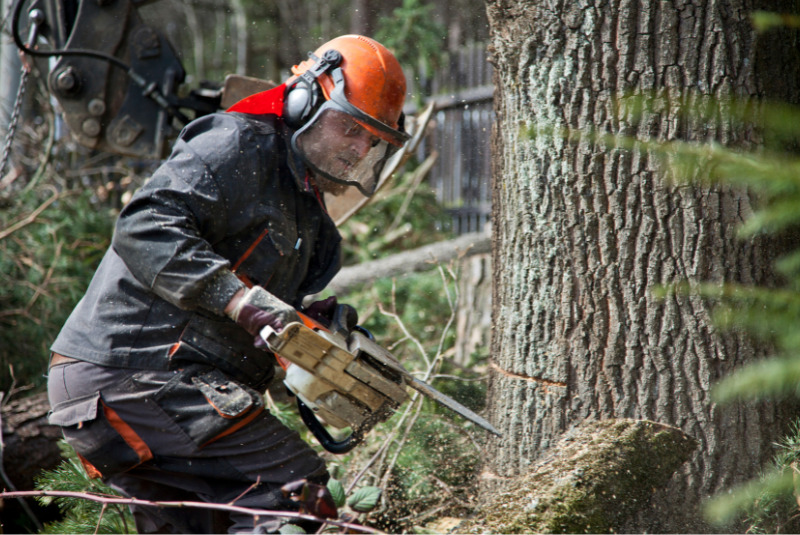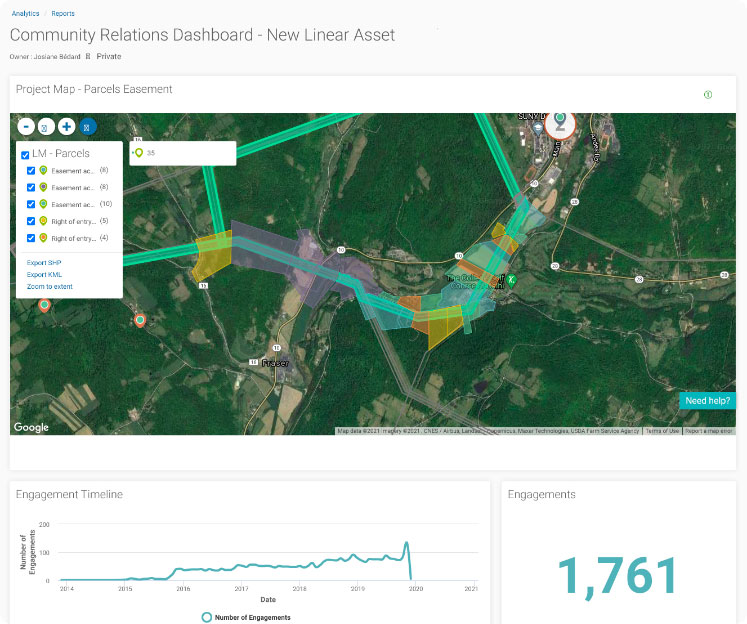Forestry is a complex industry that involves a wide range of activities, including planting, managing, exploiting and conserving forests and woodlands. The stakeholders in foresry are as diverse as the many and varied activities in this multi-faceted sector, which include, for example:
- felling trees (harvesting)
- wood product manufacturing (processing)
- protection against disease (silviculture)
- planning and monitoring resource use (management)
- restoration of natural habitats (conservation and environmental protection)
- recreational infrastructure development (tourism and leisure).
These activities are not isolated; in fact, many are natural partners and face common challenges, although each also experiences its own distinct reality. The same is true of the sector’s stakeholders. While some are linked to several areas, others are more specifically concerned with a particular aspect of the industry.
Hence the importance – whatever the project or activity – of knowing your stakeholders and understanding their role in the challenges facing the industry.
Engaging with stakeholders effectively means managing these relationships rigorously and tactfully, while also considering how they might influence the progress or outcome of the project.
This guide aims to provide forestry managers and professionals with information to help navigate the complexities of stakeholder management more effectively.
Identifying stakeholders in forestry
Forestry stakeholders are individuals or groups who have a vested interest in an organization’s policies, products, projects, or activities. Their interest often stems from the fact that they are impacted by the organization’s actions, or they represent the agencies that oversee regulatory compliance in the sector.
Identifying stakeholders is the first step in developing an effective engagement plan. The information gathered during this exercise helps an organization understand each stakeholder’s levels of interest and influence in the project, and then rank them based on their potential impact.
How to identify stakeholders in the forestry sector
- Define the project scope, focusing on the specific area or issue at stake.
- List key stakeholder groups. Be sure to include local communities, government agencies, other players in the forest industry, environmental groups, NGOs, researchers, and Indigenous communities.
- Involve local communities; their knowledge can help you identify important people and groups.
- Evaluate power dynamics to determine which stakeholders have real influence.
- Use GIS tools to map the area. Identify land use patterns and key ecological regions.
- Analyze your network to clearly understand the relationships between different stakeholders.
- Keep your list up to date. Verify that your stakeholder data is accurate and that the list includes all relevant parties.
- Be inclusive. Make sure that you involve marginalized groups to obtain a wide range of viewpoints.
- Consult public records (like government reports and land-use plans) to help identify affected parties.
- Start engaging with stakeholders in the earliest phases of a project. Establishing communication during the project planning stage allows you to gather feedback, find compromises, and address concerns before they can become issues. This is an excellent way to build trust with stakeholders.
Groups of stakeholder in the forestry sector
Stakeholders in the forest industry can be grouped into six main categories.
- Public administration and legislators
- Forestry professionals and managers
- Indigenous communities and leaders
- Environmental, social responsibility and governance (ESG) professionals
- Sustainability experts
- Project developers and land specialists

While these groups sometimes overlap, each plays a different role and presents its own challenges.
Ministries, public bodies, and political decision-makers
Who are they?
- Ministries responsible for forestry, natural resources, agriculture, the environment, conservation and tourism
- Municipal authorities who oversee urban forest management (parks and recreation, public works, etc.)
- Regional and state services and organizations that provide expertise (scientific, political), such as the Canadian Forest Service
- Industry regulators
Roles of public administrations in the forestry sector
Organizations in all parts of the forestry industry need to manage relationships with the administrative and legislative bodies who oversee forest governance. In her book, La Gouvernance des biens communs : pour une nouvelle approche des ressources naturelles (English: Governing the Commons: The evolution of collective action), Elinor Ostrom defines forest governance as “the set of rules for organizing human societies with a focus on respecting the sustainable management of forest resources.”
Stakeholders working in the public sector are responsible for managing public forests. They monitor forest environments to assess productivity, diversity, silvicultural operations, protection, harvesting, forest law enforcement; allocate budgets for conservation and natural resource management; and influence industry practices through policies and taxation.
While some policies have had (and continue to have) negative consequences, there is a growing awareness of the need to take action to protect the environment. In January 2021, for example, President Biden issued Executive Order 14008: Tackling the Climate Crisis at Home and Abroad. This includes the ‘America the Beautiful’ initiative, which aims to conserve 30% of public lands and waters by 2030. As a result of this Executive Order, the U.S. Forest Service has taken additional steps to help achieve this goal.
Challenges on both sides
The stakeholders in this group face a major challenge: reconciling economic growth with sustainable forestry practices. But for companies and organizations that need to juggle a number of different rules and regulations, the challenge is to comply with their many legal obligations. Closely monitoring this compliance is of paramount importance.
One possible solution to this challenge is to use fit-for-purpose technology tools. Borealis stakeholder management software, for example, offers a compliance management module designed specifically for this function.
Forestry professionals and managers
Who are they?
- Forestry managers, engineers, and technicians
- Foresters
- Forestry consultants
At the forefront of forest management
Forest managers and professionals are responsible for preserving and protecting forests. They are responsible for the sustainable management of areas used for timber production and public recreation, as well as those that are protected.
Some work in the field, while others work in offices. Their tasks may include:
- Planning and directing surveys and studies
- Preparing reports and recommendations
- Drawing up plans for land and resource management
- Approving activities and decisions
- Directing and supervising operations
Navigating between objectives
The stakeholders who deal with forests on a day-to-day basis must meet economic, environmental and social objectives. This requirement can complicate their overall operations, as it forces them to manage multiple relationships with a wide variety of stakeholder groups, each with their own interests.
There is no doubt that the services provided by these professionals are important and necessary to organizations like Bluesource Sustainable Forests Company, the largest privately-owned U.S. forestry company dedicated to mitigating the effects of climate change. The company manages 1.7 million acres of forest land previously used for industrial timber harvesting. But these lands are now dedicated to carbon sequestration, climate adaptation and biodiversity restoration.
This initiative proves that it is possible, even on a large scale, to reconcile these three categories of objectives.
But while the prospect of having to manage relationships with stakeholders involved in all aspects of achieving these objectives can be daunting, fortunately there are solutions that can facilitate these operations.
Local and Indigenous communities
Who are they?
- Communities affected by any of the forest sector’s activities
- Indigenous communities who hold rights to their ancestral territories
Involvement of local and Indigenous communities
Communities closely affected by the forestry sector’s activities want to benefit from their forests and their forestry operations. They also want to be sure that their forests are managed in a sustainable manner. The people who promote and manage forestry projects have every interest in developing and maintaining good relations with the people who live in project-affected areas.
Forestry projects are likely to have an impact on the culture, way of life, and well-being of local communities. Consent and collaboration are therefore often legally required, and can lead to fruitful partnerships. Also, integrating local perspectives into the planning and management of forestry projects promotes environmental, social and economic sustainability.
Because of their legal standing, Indigenous peoples play a special role in forest management. On one hand, they hold rights to their traditional lands that must be recognized and respected. On the other, their ancestral knowledge of nature can contribute to more sustainable forest management.
Ensuring equity and inclusion
Historically, Indigenous communities have suffered from forestry development that has often been detrimental to their interests. In Quebec (Canada), for example, a 2015 sociological study found that prior to the 2000s, aboriginal interests were virtually non-existent in Quebec’s forestry regime. This had a significant impact, particularly on subsistence activities, such as hunting, trapping and fishing.
According to the same study, the system put in place since then is not perfect, but there are now mandatory consultation and participation mechanisms in place. This demonstrates an evolution in the way First Nations peoples are treated. This comprehensive legal obligation is supported by the United Nations Declaration on the Rights of Indigenous Peoples. It is now included in government requirements for foresters around the world.
ESG and sustainability in the forestry sector
Who are they?
- Environmental impact assessors
- Sustainability managers
- ESG consultants
- Forest policy specialists
- Community liaison officers
- Forest Stewardship Council (FSC)
- Food and Agriculture Organization (FAO)
- World Bank
The roles of GSE professionals in forestry
ESG professionals play an essential role in the forestry sector. They assess the environmental, social and governance risks associated with projects and develop strategies to improve sustainability. In some cases, they may monitor forestry operations for compliance and prepare detailed reports on companies’ ESG practices and performance. ESG professionals promote the continuous improvement of forestry practices to reduce their impact on the environment and local communities.
The position of ESG stakeholders allows them to simplify communications between the company and its other stakeholders. They can organize consultations or educational exercises to raise awareness, respond to requests, and answer questions by providing accessible reports. Finally, they can act as mediators in conflicts between the company and local communities or other interest groups.
Fostering a sustainable future
On a global scale, a number of major players are involved in promoting ESG and sustainability values and implementing related projects. These include the FAO and the World Bank.
The Forest Stewardship Council (FSC) is an international organization that offers certification programs to ensure that products are sourced from sustainable sources. The group is invited to participate in many different types of projects, and they involve stakeholders from diverse backgrounds (including representatives of the timber industry, environmental organizations, Indigenous communities, and others) in the decision-making process. The FSC recognizes the value of engagement and dialogue, and even publishes a guide to stakeholder engagement.
Project development and land management professionals
Who are they?
- Private companies
- NGOS
- Communities
- Government agencies
- Land managers
- Natural resource management analysts
- Forest land management consultants
The responsibilities of project developers and land specialists
People who develop projects in the forestry sector do so for economic, environmental, and social reasons.
Some exploit the forest for timber production. Others extract “non-timber forest products” (NTFPs) such as mushrooms, maple syrup, Christmas trees and wreaths, and substances from forest plants that are used to manufacture pharmaceutical and hygiene products.
Projects can also involve :
- restoration of forest ecosystems
- forestation and reforestation
- ecological conservation and restoration
- agroforestry
- ecotourism
- biomass production
- and much more
Land management specialists, for their part, contribute to the sustainability of forestry practices. They plan land use, manage land ownership issues, ensure compliance with laws and regulations, monitor land conditions and evaluate the effectiveness of existing management practices.
What use for the land?
Developers and land managers are concerned by the same issues as most players in the sector. They must adapt to climate change, managing the increased risks of fire, disease and infestation. They are under pressure to make sustainable practices profitable, and must constantly adapt to complex and changing regulations.
However, they are also the main entities affected by land-use conflicts, where several interests are at stake. After all, industrial development cannot be carried out without considering the rights of Indigenous peoples and the imperatives of conservation and biodiversity.

To facilitate land management, Borealis software offers a dedicated Land Management module that optimizes the stakeholder engagement process with data centralization and mapping tools.
Deciphering and taming the ecosystem
Whatever the project or undertaking in the forestry sector, a stakeholder management and mobilization plan is necessary to help meet ESG criteria and sustainable development objectives.
Governments at all levels are a vitally important stakeholder group, as failure to comply with their requirements can have consequences that jeopardize the continuity of work or even the success of a project.
That said, all players in the sector are important, whether they are on the participation side (industry professionals) or the claims side (Indigenous communities).
To make matters even more complicated, some individuals and organizations are part of more than one group, and those interests must also be reconciled. A community may want to set up a project, but have to convince some of its members of the merits. Land managers may include ESG specialists and advocates of local community rights.
What’s the key takeaway here? Effective interactions and exchanges with all of these stakeholder groups is the best way for a project to achieve the all-important balance between profitability and sustainability.
With its many fit-for-purpose modules, Borealis software provides teams in the forestry sector with a complete solution for managing all aspects of stakeholder relations.





